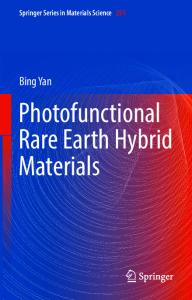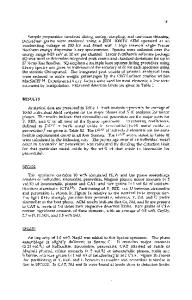The roles of rare earth dispersoids and process
- PDF / 4,539,066 Bytes
- 11 Pages / 597 x 774 pts Page_size
- 83 Downloads / 304 Views
I.
INTRODUCTION
R A P I D solidification has permitted the synthesis of titanium alloys containing rare earth dispersoids, ttl Processing and consolidation of these alloys at low temperatures yield fine particles capable of dispersion hardening at room temperature through 700 ~ t21 Beta heat treatment of rare earth containing alloys coarsens the dispersoids and renders them ineffective for dispersion strengthening; however, dispersoids can control the beta grain size and shape during processing and heat treatment. t3j Alloys with high levels of alpha-2 forming elements and containing rare earth dispersoids have higher room temperature tensile ductilities than comparable alloy chemistries without the dispersoids; alloy chemistries with dispersoids have been synthesized which are ductile at room temperature and possess a 140 ~ capability increase in tensile and creep strength over Ti6242. t41 Studies of thermomechanical processing of rare earth containing alloys showed that strong crystallographic texture and high strength could be achieved by processing at temperatures above the beta transus, tS~ Because of the strong roles of rare earth level and thermomechanical processing routes on tensile and creep properties, this work was carried out to study the effects of those parameters on the low cycle fatigue resistance of a highstrength near-alpha titanium alloy. II.
PROCEDURE
A. Alloy Chemistry A single alloy matrix composition was selected and evaluated with and without a rare earth addition. The alloy matrix evaluated in this study had a composition, in atomic percent, Ti- 11.6A1-1.3Sn- 1.6Zr-0.7Hf-0.5Nb0.14Ru-0.3Si-0.2Ge. The composition was evaluated with 0 and 0.5 at. pct Er.
B. Material Characteristics The alloys were prepared as powder at Crucible Research, Inc., Pittsburgh, PA. Their pilot powder production process uses skull induction melting and argon M.F.X. GIGLIOTTI, Jr., Metallurgist, is with General Electric Corporate Research and Development, Schenectady, NY 12301. A.P. WOODFIELD, Metallurgist, is with General Electric Aircraft Engines, Evendale, OH 45215. Manuscript submitted September 30, 1992. METALLURGICAL TRANSACTIONS A
gas atomization for heats up to 23 kg.16] The powder procured was sized to - 3 5 mesh. Measured oxygen content of the powder ranged from 0.29 to 0.42 at. pct for the 0 Er powder and 0.34 to 0.46 at. pet for the 0.5 Er powder. The beta transus of consolidated material was measured to be 1030 ~ for 0 Er and 1023 ~ for 0.5 Er. Since oxygen in solution in titanium raises the beta transus temperature, the slightly lower transus temperature for the 0.5 Er forging could be due to the internal oxidation of Er, forming erbia (Er203), and hence the oxygen not being in titanium solution.
C. Process Routes The alloys were prepared by hot isostatic pressing (HIP) plus forging or HIP plus extrusion. The process routes evaluated were the following: (1) forging above the beta transus temperature, "beta forging"; (2) forging while the temperature cooled from above the beta transus temperature
Data Loading...











